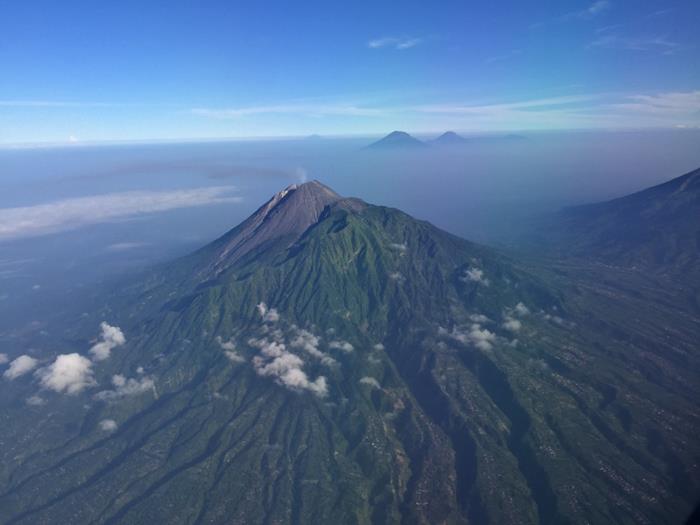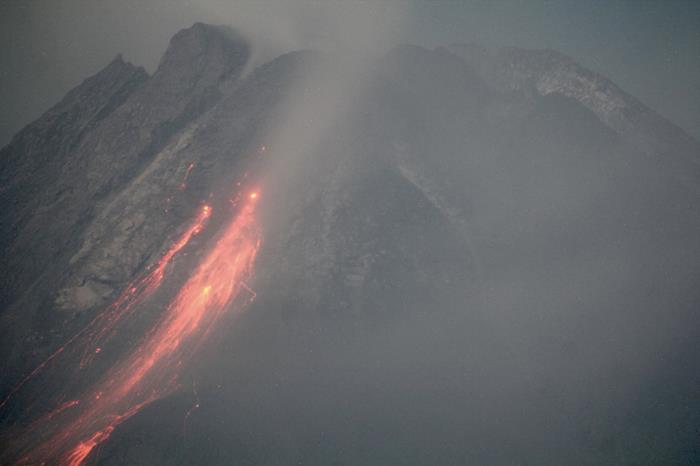We usually know when a volcano is showing signs of unrest. But unraveling the type of volcanic activity from monitoring data is still challenging due the complex nature of volcanic processes. Our new study shows that the level of seismic energy measured at stations located around volcanoes can detect episodes of lava extrusion. This occurs when lava emerges from the volcano and breaks the rocks, creating seismicity. This finding helps anticipate the pyroclastic flow hazards when the extruded lava collapses from the volcano summit and will be particularly useful for responding to future volcanic crises.
In our study, published in the Journal of Volcanology and Geothermal Research, we looked at seismic data recorded between 1993 and 2012 at Merapi volcano, one of the most active volcanoes in the world located on the island of Java in Indonesia. During this period, Merapi exhibited a range of different eruption phases, including continuous lava extrusion that formed a lava dome at the top of the volcano, small explosions driven by steam, and a multi-stage eruption phases that climaxed in a large explosion forming a new summit crater.
Merapi has impacted local communities for many years, with more than half million people living in disaster-prone areas and more than five million within 30 kilometres (km) of the volcano. Merapi can also produce large eruptions that can affect the wider Southeast Asia region including Singapore, which is only 1,230 km away.

Merapi from above, showing the densely populated areas on the southeastern flank of the volcano (Source: Christina Widiwijayanti/Earth Observatory of Singapore)
In our study, we used monitoring data to detect specific eruption phases and reliably assess the associated volcanic hazard. To do so, we calculated the chance of observing an eruption phase given the daily seismic energy by performing a statistical analysis to calculate probabilities for different scenarios. This enabled us to assess whether there is a relationship between seismic energy and lava extrusion phases.
Because such analysis relies heavily on quality of the data, it was essential to have standardised monitoring data to compare with eruptive phases for the same volcano. The WOVOdat database of volcanic unrest provided the data we needed. It stores and facilitates access to standardised time series of monitoring data for different volcanoes across the world. A large dataset of almost 20 years of standardised and continuous seismic energy time series for Merapi are available in the database – a result of collaboration between the Centre for Volcanology and Geological Hazard Mitigation (CVGHM) in Indonesia and the WOVOdat team.

Part of the WOVOdat team, from left to right: Nang Thin Zar Win, Christina Widiwijayanti and Tania Espinosa-Ortega (Source: Christina Widiwijayanti/Earth Observatory of Singapore)
Defining a link between seismic energy and lava extrusion
We developed a simple and general probabilistic approach to correlate seismic energy time series with periods of lava extrusion.
First, we classified the seismic energy levels recorded during phases of lava extrusion at Merapi between 1993 and 2012 and calculated the probability of detecting lava extrusion phases for different daily seismic energy levels. For this purpose, we specifically used the total daily seismic energy of multiphase or hybrid earthquake type, which characterise shallow brittle rock failure related to lava dome building. For the days when lava extrusion was uncertain, we simulated different scenarios where the duration of the lava extrusion was varied randomly within the uncertainty windows. Our results are very promising as we reliably identified a seismic energy threshold associated with the lava extrusion phase, above which with we could detect lava extrusion with high precision and high accuracy.
Improving hazard assessment at Merapi
To validate and evaluate the performance of this new method, we applied the same technique to another dataset: the seismic data time series of the Merapi 2018 lava dome forming eruption. Our method indicates that lava extrusion occurred 14 days earlier than what the monitoring webcams detected. This shows the potential of the method for early detection of future lava extrusion episodes at Merapi.
We also showed that the majority of the most energetic Merapi pyroclastic flows that occurred between 1993 to 2012, which usually resulted from the collapse of the partial lava dome material, occurred within the first three months after the onset of the lava extrusion phase.

Image of lava extrusion at the southwest lava dome of Merapi taken from the CVGHM camera at Tunggularum station on 17 April 2022. The extruded lava flowed down the steep slope and produced glowing rockfalls (Source: CVGHM)
By identifying specific eruption phases from monitoring data, our study can help improve quantitative assessments of hazards during volcanic crisis and, ultimately, help mitigate the impacts of any impending hazards.
This research was done by the WOVOdat team including former EOS Principal Investigator Fidel Costa. It greatly benefited from our collaboration with the CVGHM, especially with A. Budi-Santoso and Sulistiyani. It is part of the ongoing collaboration between Nanyang Technological University Singapore and the Geological Agency of Indonesia, and the ongoing collaboration between the Earth Observatory of Singapore and CVGHM.